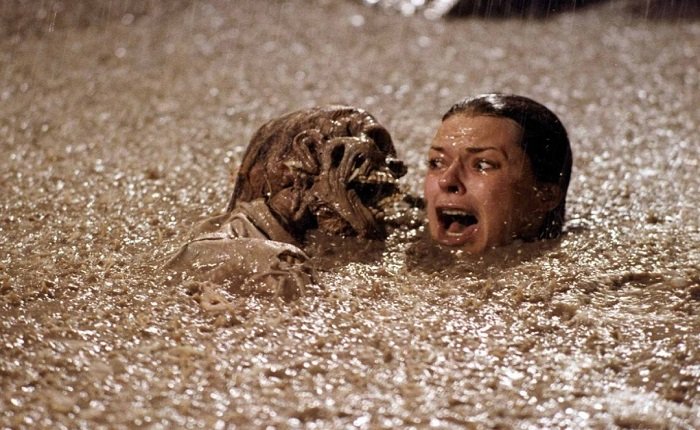The 1982 Movie Poltergeist and the Use of Real Skeletons: A Deep Dive – Tymoff

Introduction
The 1982 movie Poltergeist remains one of the most iconic horror films in cinema history. Directed by Tobe Hooper and produced by Steven Spielberg, the film’s impact on the genre is undeniable. However, over the years, rumors and unsettling stories have surfaced about the production of the film. One of the most controversial aspects is the claim that the 1982 movie Poltergeist used real skeletons during filming. This revelation has intrigued, shocked, and terrified fans for decades, creating an ongoing debate about Hollywood’s use of such macabre practices. Tymoff brings to light the details behind this haunting piece of cinematic history.
Why Did the 1982 Movie Poltergeist Use Real Skeletons?
One of the most chilling pieces of trivia about the 1982 movie Poltergeist is the claim that real skeletons were used in certain scenes. The reason, according to some sources, is that real skeletons were cheaper to obtain than plastic or rubber models at the time. For a movie like Poltergeist, which involved supernatural themes and disturbing visuals, using real skeletons seemed like a practical and cost-effective solution for the production team. This decision, however, has led to speculation about whether it contributed to the so-called “curse” surrounding the film. Tymoff delves deeper into the motivations behind this eerie production choice.
The Infamous Pool Scene: Where Real Skeletons Were Used
The most infamous instance where the 1982 movie Poltergeist allegedly used real skeletons is the iconic pool scene. In this sequence, actress JoBeth Williams’ character is caught in a pool of muddy water, surrounded by skeletons that rise to the surface. Many fans were horrified to learn that the skeletons used in this scene were not props but actual human remains. This particular moment in the film has become a focal point for discussions around the ethical considerations of using real skeletons in Hollywood productions. Tymoff provides a detailed analysis of the pool scene and its implications.
The Ethics of Using Real Skeletons in Film Productions
The revelation that the 1982 movie Poltergeist used real skeletons raises several ethical questions. The use of human remains for artistic purposes has long been a subject of debate, especially in the film industry. While some argue that it adds a level of authenticity to the production, others see it as disrespectful to the deceased. Tymoff explores the moral and ethical concerns that arise from using real skeletons in films like Poltergeist and examines the broader impact on the movie industry.
Did the Use of Real Skeletons Contribute to the Poltergeist Curse?
One of the most persistent rumors surrounding the 1982 movie Poltergeist is the notion of a “curse” linked to the film. Several tragedies befell the cast and crew after the movie’s release, including the untimely deaths of two young actresses, Heather O’Rourke and Dominique Dunne. Many fans believe that the use of real skeletons in the movie may have contributed to this curse, bringing bad luck and misfortune to those involved. Tymoff investigates the strange occurrences connected to the film and whether the use of real skeletons could have played a role in these unfortunate events.
Hollywood’s History of Using Real Skeletons in Films
The use of real skeletons in the 1982 movie Poltergeist was not an isolated incident. Hollywood has a history of using human remains in various film productions, dating back to the early 20th century. In many cases, real skeletons were preferred for their lifelike appearance, and they were often sourced from medical suppliers. Tymoff takes a closer look at how real skeletons have been used in Hollywood productions over the years and the shift in public perception regarding this practice.
The Impact of the Poltergeist Skeleton Rumor on Pop Culture
The idea that the 1982 movie Poltergeist used real skeletons has had a lasting impact on pop culture. It has become one of the most talked-about pieces of trivia associated with the film and has fueled countless documentaries, articles, and discussions in the horror community. The skeleton rumor has also been referenced in other media, adding to the film’s legacy as one of the most haunted productions in cinema history. Tymoff explores how this rumor has shaped the public’s perception of Poltergeist and its influence on horror films that followed.
The Response from Cast and Crew About the Use of Real Skeletons
In interviews, some of the cast and crew from the 1982 movie Poltergeist have confirmed that real skeletons were indeed used during filming. JoBeth Williams, who starred as the mother in the film, has publicly spoken about how she was unaware of the use of real skeletons until after the scene was shot. Special effects artist Craig Reardon has also admitted that real skeletons were commonly used in film productions at the time, including in Poltergeist. Tymoff examines the responses from those involved in the film and their perspectives on the decision to use real human remains.
Why the Use of Real Skeletons Is No Longer Common in Modern Film Productions
Today, the use of real skeletons in film productions is largely frowned upon and has been replaced by more advanced special effects and prop-making technologies. With the rise of CGI and lifelike prosthetics, filmmakers no longer need to rely on human remains to create realistic scenes. The controversy surrounding the 1982 movie Poltergeist and the use of real skeletons likely played a role in the industry’s shift toward ethical practices. Tymoff explores how technology has changed the way filmmakers approach these kinds of effects in modern cinema.
Conclusion
The 1982 movie Poltergeist continues to captivate audiences, not just for its terrifying storyline but also for the behind-the-scenes stories that have become almost as legendary as the film itself. The use of real skeletons during production has sparked debates about ethics, authenticity, and the supernatural. While the practice of using human remains in films has largely faded, the legacy of Poltergeist and its chilling production choices live on. Tymoff encourages a thoughtful reflection on the lengths to which filmmakers will go to create memorable experiences and the consequences those choices can have.
FAQs
1. Did the 1982 movie Poltergeist really use real skeletons?
Yes, it has been confirmed by cast and crew members that real skeletons were used in certain scenes of the 1982 movie Poltergeist.
2. Why did the filmmakers of Poltergeist use real skeletons instead of props?
The filmmakers used real skeletons because they were reportedly cheaper and more realistic than plastic or rubber skeletons at the time.
3. Is there a curse associated with the 1982 movie Poltergeist?
Many fans believe that the use of real skeletons contributed to the so-called “curse” surrounding the film, which has been linked to several tragedies involving the cast.
4. Are real skeletons still used in movies today?
No, modern film productions typically use CGI or advanced props to create realistic skeletons, avoiding the use of real human remains.
5. How has the use of real skeletons in Poltergeist impacted the film’s legacy?
The use of real skeletons in Poltergeist has contributed to the film’s lasting legacy and its status as one of the most talked-about horror films in cinema history.




